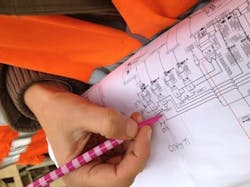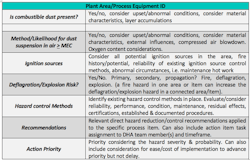Address Explosion Risks Via Dust Hazards Analysis
Many industrial facilities handle combustible particulate material that pose fire and explosion hazards. Managing combustible dust hazards is critical to ensure the safety of the plant personnel and operations. In order to effectively manage combustible dust hazards, they must first be identified and understood. A dust hazards analysis (DHA) is a systematic review and assessment of a process and/or facility led by someone with knowledge and experience in understanding and identifying combustible dust hazards. A DHA is a tool to help plant managers and operators address and manage hazards that may not have been otherwise obvious. It is also a documented record of awareness that places a diligence and duty on the plant manager/owner to address the hazards.
Compliance with the NFPA standards for combustible dust safety, especially NFPA 652 Standard on the Fundamentals of Combustible Dust 2019, requires that a DHA be completed for new and existing processes and facilities where combustible dust is present. (The surpassed deadline for DHA completion was September 7, 2020. Note the upcoming January 1, 2022 deadline for existing agricultural and food processing facilities not undergoing significant modification.) DHA’s must also be reviewed and updated every five years.
An effective DHA includes information to classify and quantify the material(s) as a combustible dust. This is often by reference to material explosibility testing of representative samples of the dust handled and present in the actual facility and processes. This may include one or various materials or forms of a single material in a facility. Influential factors can include particle size and moisture content.
The bulk value of a DHA comes from the analysis of each area, process operation and equipment where combustible dust is or may be present. The analysis identifies specific combustible dust fire, flash fire and explosion hazards as well as the potential implications of the hazard event. Combustible dust hazards are assessed on the basis of the dust explosion pentagon components: fuel, oxygen, ignition source, fuel dispersion in air above the minimum explosion concentration and containment. A definitive absence of one component rules out the probability of the dust explosion; however, fire and flash fire can be still highly probable. The hazards are identified under the conditions of both normal operation and abnormal or upset conditions. Existing safeguards and hazard reduction or management methods shall be clearly indicated and documented but also assessed for application suitability, reliability and maintenance.
One of the most important aspects of the DHA is specific recommendations to manage the identified hazards and the residual effects or secondary hazards. Recommendations should be as specific as possible and prioritized according to severity and probability of the hazard.
Additional components of a DHA include assessment, review and recommendations of documentation and procedures with an influence on combustible dust safety. Such procedures include hot work programs; employee and contractor awareness and safety training; safety/protection systems maintenance and documentation; management of change procedures; and combustible dust housekeeping.
Following preparation of the DHA document, the job is not finished. In fact, the real work is just beginning. The DHA team must then use the identified recommendations to prepare a prioritized action item list with specific tasks, assigned parties, target timeframes and required resources. This serves as both a guide to hazard reduction and a working document demonstrating reasonable effort towards managing risk.
So, in review:
• A dust hazards analysis (DHA) must be completed to be compliant with NFPA standards and is a useful tool for diagnosing and remedying deficiencies in managing combustible dust risks in industrial processes and facilities.
• NFPA 652 requires that the process be led by someone with knowledge and experience in understanding and identifying combustible dust hazards.
• Dust testing is a critical step in the process of a DHA so the dust hazards can be appropriately categorized and addressed.
• Recommendations for addressing deficiencies in managing combustible dust hazards must be documented and addressed in a timely fashion acceptable to the authority having jurisdiction.
• The DHA must be reviewed every five years or updated as processes, equipment or other changes are implemented.
A DHA is a useful tool and resource to manage dust rather than sit on a shelf and collect it.
Jeramy Slaunwhite, P.Eng, is a Mechanical Engineering graduate from Dalhousie University in Halifax, Nova Scotia, Canada. He has over 13 years of applied engineering experience. Slaunwhite has developed expertise in manufacturing, consulting and governmental environments in fields including material handling, industrial ventilation, mechanical building systems, energy conservation and project management. Slaunwhite's career focus on industrial combustible dust assessment and design has developed his exceptional familiarity with the NFPA standards for combustible dust safety. Slaunwhite joined REMBE Inc. in 2018 as their North American explosion safety consultant. He applies his combustible dust knowledge on explosion safety solutions and technical support for various industries and applications with a focus on NFPA compliance and risk management methodology.

